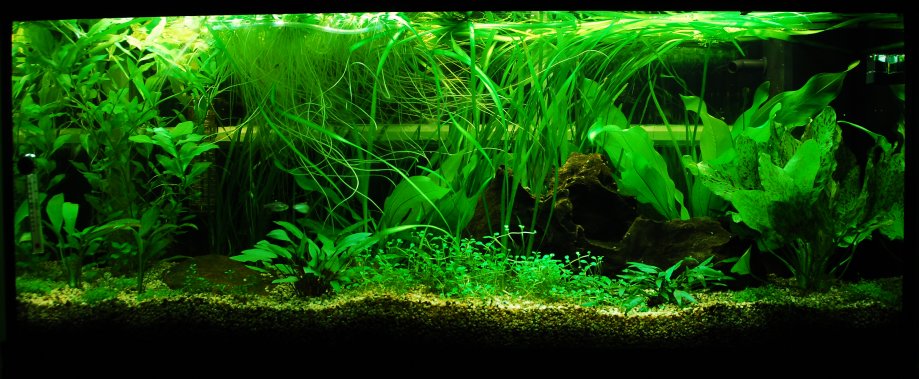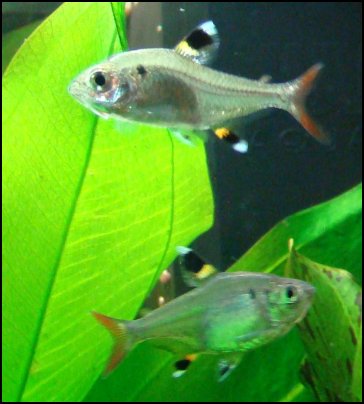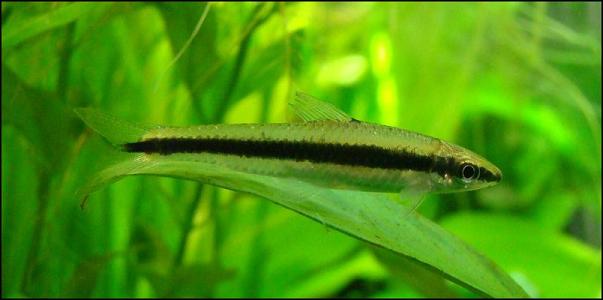
The tank the day that I put the first fish in.
| eRodent > Tropical Aquarium > Planted Aquarium Residents and Quarantine. |
This page is about the residents in my Planted Tropical Aquarium. I was a complete novice when I started having never owned tropical fish before and had some problems getting the tank set up and cycled.
 The tank the day that I put the first fish in. |
Quarantine.
I had health problems with my first fish and now am a firm believer in quarantining fish and have bought a 60l tank for this purpose. I only buy fish from a good local shop (Sweet Knowle Aquatics) that quarantines all their stock, and then quarantine myself for 2-4 weeks. This tank is a Hagen Elite 60 - I had to buy this in a hurry and it's an ok tank but I have ended up replacing the filter (the stingray that comes with it really isn't up to the job), the heater (started to overheat after a few months) and the light tube (not strong enough for plant growth and replaced with a T8). The filter is now an Eheim Aquaball and the heater a Rena SmartHeater, both good quality. I also could never use the stand that comes with this tank - it just wasn't stable enough and I had a 'tiny table' built for it so it could go in a gap I had.
 My Quarantine Tank. |
Pristella Tetras.
After a great deal of thought I decided that my first fish were going to be Pristella Tetras (also known as x-ray tetras). This is because they area fairly hardy species of tetra and I also think that they are very beautiful in a subtle way. They have striped yellow and black fins, a silver body and a bronze coloured tail when they are happy.
 The top fish is the sick tetra. |
Siamese Algae Eater.
It was a difficult decision deciding which algae eater to buy. I already had a couple of nerite snails and didn't really have a problem with green algae, but staghorn was a bit of a problem. The only fish or invert that will reliably eat this is a Siamese Algae Eater (SAE). Unfortunately they get quite large - up to 6" and there are a number of different species that can be mistakenly sold as a SAE, such as the more territorial Flying Fox, that is not such a good eater. A good thread on identifying Siamese Algae eaters on Practical Fish Keeping forums to help you ensure you buy the right fish.
 Nutter when I first got him. |
Zebra Nerites and Pest Snails.
I bought a couple of stripy snails (zebra nerites) with my first set of tetras. They are rather cute little fellas and happily munch away at the algae without damaging the plants. That said they seem to prefer the bogwood to pretty much anything else. Sadly as I said above I moved them back into the main tank too soon after it had been treated with wormer and they died. I left it several months and kept track of the water changes I did until I was sure that there was less than 0.5% of the water that had been treated left (as well as having a carbon filter running). Then I bought some 'candy nerites' and introduced them to the main tank after quarantining them.Cardinal Tetras.
My second fish, once I'd finally sorted the parasite problem in May, were half a dozen cardinal tetras. This time I used the quarantine tank, took a few days to settle down but are now happily swimming around with the other fish. They can also be seen in the SAE video.
 Cardinal Tetra. |
Glowlight Tetras.
After another break so as not to have fish in the quarantine tank when I was on holiday I decided on some little Glowlight tetras in early July. These guys were absolutely tiny when I got them and spent 4 weeks in the quarantine tank getting up to size so that I felt safe to move them. The Glowlights lurked around the back of the main tank a little initially but soon started to swim around more and coloured up nicely.Peru Green Strip Corydoras.
So I then preceded to get (possible) swine flu, leaving me quarantined in the house, with an empty quarantine tank. I didn't want to leave it empty as I'd need to recycle it so I sent the husband out to buy me some fish. These little fellas came back. They are Peru green stripe Corydoras, not cheap but absolutely beautiful. They have neon green stripes down their sides. The substrate isn't ideal for them - in the main tank I've got a layer of smooth gravel over the top. Several months down the line they seem to have healthy barbels - I have heard that dirty substrate is more of a problem than gravel. However they are very shy and tend to hide under the bogwood for much of the time so maybe a less exotic species would have been better. I'd like to move them into the new tank I am setting up with a sand substrate but doubt I would ever catch them. They are also a little difficult to feed, but I drop Hikari sinking wafers in at lights out for them.
Click here to see the video on YouTube if it does not appear below because of your security settings.
Pitbull/Dwarf Gold Spot Plecos.
Click here to see the video on YouTube if it does not appear below because of your security settings.
The label on this video is wrong - it's spotty the Dwarf Gold Spot Pleco
 Paratocinclus Spilosoma. |
Zebra Danios.
My latest additions are a small group of Zebra Danios in the quarantine tank. Often overlooked because they are so common, they are really beautiful little fellas with their blue and silver stripes and are endlessly interesting zipping around the little tank. Originally bought to keep the quarantine tank cycled they are now going to be first residents in a new stream biotope tank I am started. Do you like this page? Is it useful? Please email me at paula@eRodent.co.uk and let me know. Put something about aquariums in the title so I can pick it out if my spam filter gets it.| Back to Main Page |